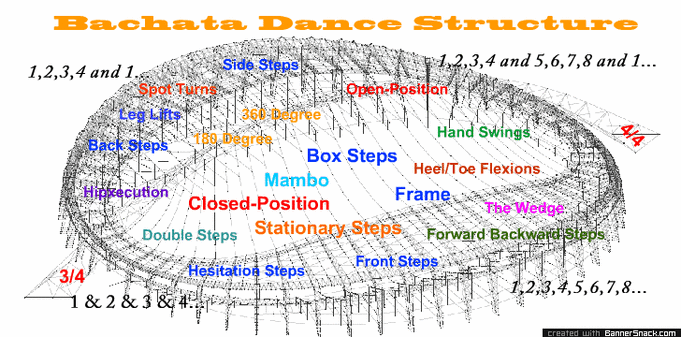
How does bachata look like?
How is it danced?
If you are in the bachata dance world, you’d notice that there has been numerous discussions and debates about the root and structure of bachata dancing. Some say that Bachata is a feeling; a dance party; a simple dance that’s easier than salsa, but they never truly defined bachata's structure in a specific manner.
It has been 6 years since the first bachata festival in the world was celebrated in Sydney, Australia, followed by the first bachata festival in the Reno (USA) in 2009, yet, to this day, you cannot find concrete and specific descriptions on what bachata dance structure is.
Bachata is a style of partner dance that originated in the Dominican Republic inlfuenced by Bolero, Son and Merengue. It is danced widely all over the world but not identically.
The basics to the dance are three-steps with hip motions, followed by a half-second pause with a step or a tap (4th beat). The knees should be slightly bent so the dancer can allow the hips to move freely.
During a dance, the leader can decide whether to dance in open (1 to 2 feet apart) or closed position (no space between). Dance moves, or step variety, during dancing always depends on the music (such as urban, techno or tradicional), setting, mood, and interpretation. Unlike salsa, Bachata dance does not usually include turn or spin patterns but they are used more and more as the dance evolves and fusionized. The leading is done just like in most other partner dances, with a “push/pull” or “swing” hand and arm communication. Hand and arm communication is better conveyed when the movements are applied by the hips and footwork.
The way they dance in Dominican Republic is a basic dance sequence in a full 8 (4, technically, keeping music structure into account) count moving within a square or small circle. Dancers in Europe and USA later began developing a more simple movement and added dance elements from other dances as well, and somewhat changing the structure. The basic is also in a full 8 count, but with a side-to-side motion (which isn’t part of the original bachata).
The Original Structure of Bachata Dance
Front Steps
A step that begins with a tap in a forward motion. (4 steps)
Side Steps
A step that begins with a tap in a sideward motion. (4 steps)
Back Steps
A step that begins with a tap in a backward motion. (4 steps)
Note: These steps are not traveling steps.
Forward/Backward Steps
Steps that starts with a left foot by the leader in linear direction
Double Steps
The double steps occurs on the fourth beat with a half-second pause followed by a step and quick step from the other foot. (it’s not a chachacha beat or triple steps)
Box Steps
A step that begins with the left foot to the side, right foot forward, left foot forward with the fourth beat being a tap with the right foot completing “the box”
Stationary Steps
A unique move on the spot without moving to any directions yet being performed with 4 steps.
Arm Swing
Moves that resembles hand waving with a swing causing the leader sometimes to initiate tension of the arms (push/pull or in/out)
Closed Position
A partnering position creating no space between partners
Open Position
A partnering position creating a small or big space between partners during a dance
Two Types of an Open Position
- an open embrace (leader’s right hand on the follower’s shoulder blade or hip and left hand holding follower’s right hand)
- Leader’s holding both hands of the follower (upward position or lower position)
180 Degree Turn
A half circular turning move for a couple
360 Degree Turn
A full circular turning move for a couple
Hipxecutions (Hip Movements)
-Explanations
Hip movements with no pauses matching 4 beats of the music
Hip movements that pauses on the 4th beat
Rapid Hip movements that matches a rapid rhythm of the guitar (mambo)
Beats
3/4 (no tapping the foot on the 4th beat - Bolero)
4/4 (w/ tapping on the 4th Beat)
The Count Structure
1,2,3,4,5,6,7,8 (Standard Counting)
1&2&3&4 (Delayed Count)
1,2,3,4 and 5, 6,7,8 and 1 (Counting w/ Double Steps)
Structure and Branches of the Structure are illustrated on the photo attached to this article above.
As you can see the photo, a dance structure is like a building, and it’s something made up of a number of parts that are held or put together in a particular way; the way in which parts are arranged or put together to form a whole. In other words, if you were to change the “original structure” of the building, you’d have to demolish it and pretty much build a new one.
This explains why some dancers often say, “that isn’t bachata” or “that doesn’t look like bachata”
Moves and New moves should be based from the structure.
I’ll end this article with a few notables...
There is no side to side steps (we often call it Electric Slide) in the tradicional or original bachata
- There are no spins
- There are no dips or lifts
- There are no patterns
- Hipxecution matches the bass, guitar, or the bongo rhythm of the music
- Since most Dominicans in DR starts the first step with a tap, with either their left or right foot, they therefore break their first step on2 or on3.
The Modern or Urban bachata type of music is danced differently due to the different music composition, yet the structure of the music is still evident (Bass, Bongo and Rhythm Guitar)
IF YOU LIKE THIS ARTICLE, LIKE IT and SHARE IT
For More Info, Videos, Articles, "LIKE" Rodney Rodchgata Aquino's HOW BACHATA IS DANCED Facebook Page here - www.Facebook.com/BachataDancing
UPCOMING DVD" The Secrets of Bachata for Advance Dancers: How Movements Are Structured
Notable Video Clips Below...
 RSS Feed
RSS Feed
